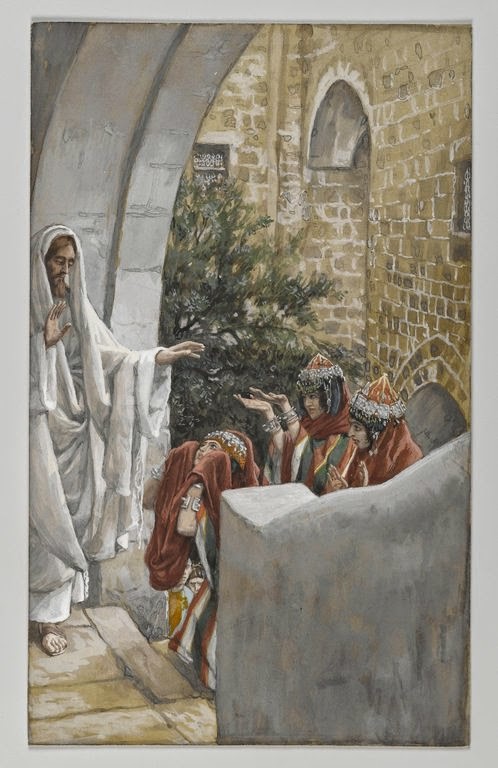Spiritual Sunday
Today I bring together one of my favorite Jesus stories and one of my favorite George Herbert poems. Both feature the image of a table.
First, today’s liturgy reading shows Jesus undergoing what appears to be a sudden and very fast learning curve. Initially reluctant to help a woman because she is not Jewish, he changes his mind after she provides a compelling analogy:
Jesus set out and went away to the region of Tyre. He entered a house and did not want anyone to know he was there. Yet he could not escape notice, but a woman whose little daughter had an unclean spirit immediately heard about him, and she came and bowed down at his feet. Now the woman was a Gentile, of Syrophoenician origin. She begged him to cast the demon out of her daughter. He said to her, “Let the children be fed first, for it is not fair to take the children’s food and throw it to the dogs.” But she answered him, “Sir, even the dogs under the table eat the children’s crumbs.” Then he said to her, “For saying that, you may go– the demon has left your daughter.” So she went home, found the child lying on the bed, and the demon gone.
The Jesus in Herbert’s “Love (3)” has no reservations about welcoming people to his table. Now it is the supplicant who is hesitant to be there. Perhaps the speaker would be bolder if he were a desperate mother with a sick child but, in any event, he longs for but feels unworthy of the spiritual sustenance that Jesus offers.
He must accept that God looks past our thrashing around in guilt and sees our best selves. Here’s the poem:
Love bade me welcome. Yet my soul drew back
Guilty of dust and sin.
But quick-eyed Love, observing me grow slack
From my first entrance in,
Drew nearer to me, sweetly questioning,
If I lacked any thing.
A guest, I answered, worthy to be here:
Love said, You shall be he.
I the unkind, ungrateful? Ah my dear,
I cannot look on thee.
Love took my hand, and smiling did reply,
Who made the eyes but I?
Truth Lord, but I have marred them: let my shame
Go where it doth deserve.
And know you not, says Love, who bore the blame?
My dear, then I will serve.
You must sit down, says Love, and taste my meat:
So I did sit and eat.
The image of people coming to the Lord’s table seems particularly appropriate in this day and age when so many refugees and immigrants are trying to find their way to the safe and heaped-up tables of the developed nations. The real solution, as Pope Francis keeps telling us, is to open our heart and wallets to these nations. Jesus learned to open his heart to the Canaanite woman and Herbert learns to open his own heart to accept God’s love. Both should function as models for all of us.
Added note: Regular reader Sue Schmidt sent me a very thoughtful set of reflections by a pastor that reads the Gospel story differently Rather than seeing Jesus as ascribing to the tribalist prejudices of his day–and then quickly evolving to a more inclusive view–the pastor believes that Jesus was using the incident as a teaching moment for his disciples. He is already fully prepared to grant the woman’s request–indeed, he tells her that he has already healed her child–but he wants her to make a case in a way that will open his disciples’ prejudiced minds, which she does. His use of the word “dog,” in other words, is not racist but ironic, gesturing toward the racism of others.Here’s the conclusion of pastor’s reflections, which very much touches on the theme of opening ourselves to refugees and immigrants:
A Greek-speaking Syrian immigrant, a single mother with a chronically ill child, reached out to a man who wasn’t her people. Wasn’t her religion. Didn’t speak her language. Whose people hated the region where she lived. In a culture where a woman who wasn’t your mother, wife, or your sister talking to you in public was considered shameful. And she did it all for the sake of her daughter. She refused to stay in the place her culture assigned her. If she had, her daughter would not have been healed.
She was so brave. She’s the hero of this story. Maybe the miracle we should pay attention to in this story wasn’t Jesus healing her daughter. Maybe the miracle Mark wants us to notice is this woman crossing all those scary and painful boundaries so that her daughter could have a fulfilling life. Maybe Jesus’ role in all this was a facilitator. He created the space for the miracle to occur. He made it possible by being there and being willing. By seeing her full humanity, and responding as a human being. She told him about someone in need. Jesus responded to the need….Responding humanly to the needs of another almost always requires crossing some boundary. Some barrier. Going to some uncomfortable place. That’s what we learn from Jesus and the Syrophoenician woman.
She crossed all these borders she wasn’t supposed to cross. And because she did, her daughter was healed.
Maybe the most profound and enduring and miraculous healing in our lives takes place when we don’t stay in our place. When we cross the boundaries our world has always told us not to cross.
I was drawn to the theory of Jesus evolving to a new position because he become more real for me if I see him as figuring things out in the course of his ministry. That being said, this other vision of him squares more with the open and accepting figure we expect. It also grants him an ironic sense of humor, gesturing towards the stereotype but fully prepared, from the first, to move past it.


